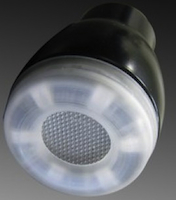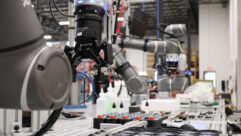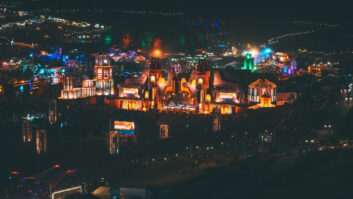

K-Array KTL22 Speaker and Light
Sep 14, 2011 4:00 PM,
by John McJunkin
A clever combination provides an all-in-one architectural solution.
K-Array KTL22 Speaker and Light
Installers and integrators deal primarily with sound and light, and among the principal devices they use are speakers and lamps. There are great speakers, and there are great lamps, and very frequently, they’re used in close proximity to each other, particularly in ceiling applications. Pendant lighting is popular and commonly used in the same kind of public spaces where installers and integrators use in-ceiling or truss-mounted speakers. The folks at K-Array decided to marry the two together and arrived at the KTL22, which is a pendant lamp with a speaker built in (and an in-ceiling version is available, the KTL22C). I recently spent some time with and was impressed by the company’s Redline speaker system, and I was excited to get a look at this unique product. I was sent a system for evaluation that included two KTL22s, a KA7 amplifier/power unit, a KU36 subwoofer, and a KLD-01 light controller.
I unboxed the system and laid it out for connection and setup. Both the sound and lighting components of the system are intended for wiring in a distributed fashion with Phoenix connectors. The KA7 amplifier not only provides amplification for the system’s speakers but also serves as a power supply for the overall system. A locking Speakon power inlet brings AC power into the amp, and an AC power passthrough link facilitates delivery of AC power to other devices. In this particular case, I connected this link to power the KLD-01 lighting controller. If it were necessary to provide AC power to other devices, the KLD-01 has a passthrough link as well, and power can be sent along in a daisy-chain fashion. I wired up the lighting controller’s output to the pair of KTL22s via Phoenix connectors. I also connected the audio amplifier’s output to the subwoofer and the speakers in the KTL22s. The KLD-01 facilitates control of lighting via sound—either with an audio line in or a built-in microphone, and I chose to keep it simple by just using the onboard mic.
The KTL22 pendant lamp/speaker is small, just short of 6in. long, 2.5in. in diameter, and about 3.25in. wide with its mounting bracket. It can indeed be mounted, or suspended as a pendant. It’s very similar to K-Array’s KT20W Tornado suspended speaker, with the addition of LED lighting. I was pleasantly surprised with the output SPL, which is rated at 101dB continuous. Bear in mind that K-Array publishes an operating frequency range of 200Hz-18kHz; indeed, there’s not much low end from the speaker’s 2in. neodymium cone driver, which sports a 3/4in. voice coil, but from the mids up through the highs, there’s enough SPL to do the trick in the kind of applications that K-Array touts it for: distributed systems for paging and music, exhibit audio for museum displays, architectural light and sound installations, and space-sensitive fill for theaters. These aren’t going to part the hair of patrons (particularly in the low-mids on down), but they deliver enough SPL to make announcements clear and make music sound good, and that’s really the point here—quality over quantity. Since the physical shape of the speaker in its enclosure is round in the horizontal plane, the distribution of sound energy is “90 degrees by 90 degrees” per se; it’s actually a round pattern, but it also has limits, so if a clear stereo image is necessary or desired, it can be achieved by spacing the units appropriately.
The lighting component of the KTL22 is comprised of six 2.5W RGB LEDs arrayed in a ring around the speaker’s exit aperture. I learned a strong lesson when I turned on the evaluation pair: They were aimed toward me and I was probably a little too close, and the light was downright blinding. The output of the elements is broken up a bit by a donut-shaped screw-on diffuser. The KLD-01 controls the lights, offering a multitude of colors, including a brilliantly bright white, strobing, and the slow evolution from one color to the next, which could make for a pleasant effect in an artistic environment. Up to four KTL22s can be controlled by a single KLD-01, and the controller units can be synchronized and externally controlled via the DMX protocol.
The KU36 subwoofer comes in a surprisingly small package, a box roughly 20in. in length, 7in. wide, and 4in. deep. I found it quite hefty, primarily due to the weight of the neodymium magnet of its single 6in. LF driver. It also features two 6in. passive radiators, which add a bit to the weight. Its solid, sturdy enclosure is made of steel as well. All in all, it comes in at a little more than 14lbs. It’s rated to deliver from 45Hz to 300Hz at 115dB continuous with peaks of 121dB SPL. These ratings may come across as improbable, but I have to say I was quite impressed with the delivery of this sub. K-Array have made some great strides in terms of loudspeakers, and this system is no exception.
K-Array KTL22 Speaker and Light
Sep 14, 2011 4:00 PM,
by John McJunkin
A clever combination provides an all-in-one architectural solution.
The KA7 amplifier is housed in a 2RU/half-rack enclosure so that multiple channels can be powered in just a few rack spaces. Its sparse burnished aluminum front panel features a power switch, cooling air intake, and LEDs to indicate power, ready, and signal presence and clipping for two input channels. The rear panel features the AC power inlet and passthrough, and powered audio outputs, all of which are Speakon connectors. Each of the amp’s two channels has XLR inputs and loop-through links, along with input pad gain knobs, ground lift buttons, and LEDs to indicate power on and limiting. Communications with other devices are accomplished via connections in the middle of the rear panel, including a USB jack, RS-485 remote jacks, and a 6-pin dipswitch to establish the address of that particular amp. The internal signal processing includes optical limiters and preset DSP to accommodate various K-Array speakers. Additionally, the amp can be controlled remotely and by computer software.
I had initially just sought to get a look at the KTL22, but it emerged that it was just a component of a larger, proprietary system, and I was quite pleased with the capabilities of the system overall. The lighting aspect of the system grants the user quite a bit of control and the capacity to nicely light spaces for various purposes. The system wouldn’t be used as a principal lighting system in a public space, but as for mood or effect lighting, it’s quite powerful. The combination of the lighting capacities with the excellent, high fidelity audio makes this system very useful, and it would impress those who experience it as unique and clever. The K-Array KTL22 and attendant system won’t be specified for a huge number of applications, but for those that do, it will have a lasting impact.
John McJunkin is the principal of Avalon Podcasting in Chandler, Ariz. He has consulted in the development of studios and installations and provides high-quality podcast production services.
Product Summary
- Company: K-Array
www.k-array.com - Product: KTL22
- Pros: Great quality light and speaker; useful for artistic and effect applications
- Cons: None to speak of
- Applications: Paging and music, museums, art exhibits, architectural, theater
Price: To come
Specifications
KTL22 Audio
- Max Power Handling: 30W
- Impedance: 32Ω
- Operating Frequency Range: 300Hz-18kHz ±3dB
- SPL (1W/1M): 87dB
- Maximum SPL: 101dB continuous, 107dB peak KTL22 Lighting
KTL22 Lighting
- Operating Voltage: 22-28VDC
- Maximum Power: 12W @ 24VDC KA7 Amplifier
- Maximum Power: 2 x 350W (@ 4Ω), 2 x 190W (@ 8Ω)
KA7 Amplifier
- Slew Rate 8Ω: 30V/μS
- S/N Ratio: >113dB/A
- THD: <0.005%
- Input Impedance: 20kΩ balanced, 10kΩ unbalanced
- Gain: 32dB
- Bandwidth: 3Hz-45kHz
- Damping Factor: >1000










